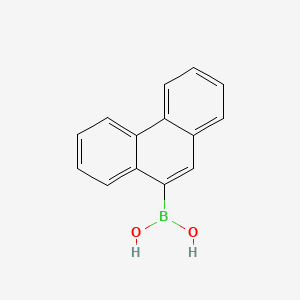Your Location:Home >Products >OLED intermediates >Boric acids >68572-87-2


Product Details
|
Chemical Properties |
White solid |
| Description | 9-Phenanthracenylboronic acid (9-PBA) is used as an fluorescent analytical reagent in sensing systems for glucose-specific detection. |
|
Uses |
Reactant involved in the synthesis of: |
Isomeric SMILES: B(C1=CC2=CC=CC=C2C3=CC=CC=C13)(O)O
InChIKey: JCDAUYWOHOLVMH-UHFFFAOYSA-N
InChI: InChI=1S/C14H11BO2/c16-15(17)14-9-10-5-1-2-6-11(10)12-7-3-4-8-13(12)14/h1-9,16-17H
Recently, interest of polymer light-emit...
To evaluate the ligand steric effects, including the bite angle in the reaction outcomes, the structural variation of the complexes was achieved by incorporating iminopyridine- and acenaphthene-based ligands. Moreover, the impact of substrate bulkiness was investigated by reacting various aryl bromides with phenylboronic acid, 2-naphthylboronic acid, and 9-phenanthracenylboronic acid. Yields were the best with the dinuclear complex, being nearly quantitative (93–99%), followed by the mononuclear complexes, giving yields of 78–98%. Consequently, α-diimine-based ligands have the potential to deliver Ni-based systems as sustainable catalysts in SMC.
Furthermore, 9-phenanthracenylboronic acid could also undergo this selenylation with a … acid bearing o-Me (26) and m-Me (27) groups. Simultaneously, disubstituted arylboronic acid …
boric acid tributyl ester
Triisopropyl borate
9-bromophenanthrene
Trimethyl borate
2-(9-phenanthryl)-5-methoxybenzaldehyde
1-[1-{2-(1-naphthyl)-5-methoxyphenyl}]-2-methoxyethene
9-(2-(epoxyethyl)-4-methoxyphenyl)phenanthrene
CAS:1001911-63-2
Molecular Formula:C<sub>18</sub> H<sub>14</sub> BNO<sub>2</sub>
Molecular Weight:287.1
CAS:1184301-61-8